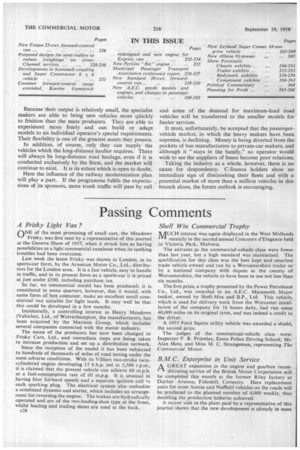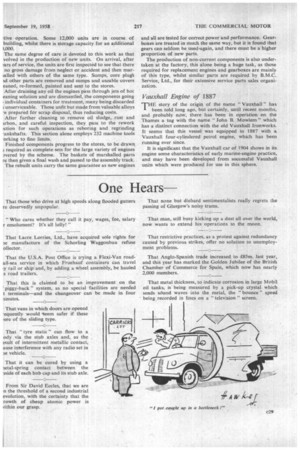Passing Comments
Page 74

Page 75

If you've noticed an error in this article please click here to report it so we can fix it.
A Frisky Light Van ?
ONE of the most promising of small cars, the Meadows Frisky, was first seen by a representative of this journal at the Geneva Show of 1957, when it struck him as having possibilities as a light commercial runabout when its teething troubles had been overcome.
Last week the latest Frisky was shown in London, in its sports-car form, by the Arneston Motor Co., Ltd., distributors for the London area. It is a fast vehicle, easy to handle in traffic, and in its present form as a sports-car it is priced at just under £500, including purchase tax.
So far, no commercial model has been produced; it is considered in some quarters, however, that it would, with some form of box container, make an excellent small commercial van suitable for light loads. It may well be that this could be developed in a few months.
Incidentally, a controlling interest in Henry Meadows (Vehicles), Ltd., of Wolverhampton, the manufacturers, has been acquired by the Marston Group, which includes several companies connected with the motor industry.
The name of the producers has how been changed to Frisky Cars, Ltd., and immediate steps are being taken to increase production and set up a distribution network.
Since the inception of the model it has been subjected to hundreds of thousands of miles of road testing under the most adverse conditions. With its Villiers two-stroke twincylindered engine developing 15 b.h.p. net at 5,500 r.p.m., it is claimed that the present vehicle can achieve 60 m.p.h. at a fuel-consumption rate of 60 m.p.g. It is unusual in having four forward speeds and a separate ignition coil to each sparking plug. The electrical system also embodies a combined dynamo and starter, which includes an arrangement for reversing the engine. The brakes are hydraulically operated and are of the two-leading-shoe type at the front, whilst leading and trailing shoes are used at the back. c28
Shell Win Commercial Trophy
MUCH interest was again displayed in the West Midlands "I recently in the second annual Concours d'Elegance held in Victoria Park, Malvern.
The entrants to the commercial-vehicle class were fewer than last year, but a high standard was maintained. The qualification for this class was the best kept and smartest trade vehicle owned and run by a Worcestershire trader or by a national company with depots in the county of Worcestershire, the vehicle to have been in use not less than six months.
The first prize, a trophy presented by the Power Petroleum Co., Ltd., was awarded to an A,E.C. Mammoth Major tanker, owned by Shell-Mex and B.P., Ltd. This vehicle, which is used for delivery work from the Worcester installation of the company for 16 hours daily, had run some 40,000 miles on its original tyres, and was indeed a credit to the driver.
A 1955 Ford Squire utility vehicle was awarded a shield, the second prize.
The judges, of the commercial-vehicle class were: Inspector'F. R. Priestley, Essex Police Driving School; Mr. Alan Hess, and Miss M. C. Strangeman,. representing The Commercial Motor.
B.M.C. Enterprise in Unit Service
A 'GREAT expansion in the engine and gearbox recon
ditioning service of the British Motor Corporation will be completed this month at the former Riley factory at Durbar Avenue, Foleshill, Coventry. Here replacement units for most Austin and Nuffield vehicles on the roads will be produced to the planned number of 4,000 weekly, thus doubling the production hitherto achieved.
A recent visit to the plant paid by a representative of this journal shows that the new development is already in most live operation. Some 12,000 units are in course of building, whilst there is storage capacity for an additional 1,000.
The same degree of care is devoted to this work as that volved in the production of new units.. On arrival, after ;ars of service, the units are first inspected to see that-there no gross damage from neglect or accident and then marailed with others of the same type. Sumps, core plug id other parts are removed and sumps and.useable covers caned, re-formed, painted and sent to the stores.
After draining any oil the engines pass through jets of hot eaning solution and are dismantled, the components going individual containers for treatment, many being discarded ; unserviceable. Those unfit but made from valuable alloys -e prepared frir scrap disposal, thus reducing costs.
After further cleaning to remove oil sludge, rust and trbon, and careful inspection, they, pass to the rework ction for such operations as reboring and regrinding -ankshafts. This section alone employs 232 machine tools
• orking to fine limits.
Finished components progress to the stores, to be drawn required as complete sets for the large variety of engines were4.1 by the scheme. The baskets of marshalled parts re then given a final wash and passed to the assembly track. The rebuilt units carry the same guarantee as new engines and all are tested for correct power and performance. Gearboxes are treated in much the same way, but it is found that gears can seldom be used-again, and there must be a higher proportion of new parts.
The production of non-current components is also undertaken at the factory, this alone being a huge task, as those required for replacement engines and gearboxes are mainly of this type, whilst similar parts are required by B.M.C. Service, Ltd., for their extensive service parts safes organization.
Vauxhall Engine of 1887 THE story of the origin of the name " Vauxhall " has been told long ago, but certainly, until recent months, and probably now, there has been in operation on the Thames a tug with the name 'John B. Mowlem " which has a distinct connection with the old Vauxhall Ironworks. It seems that this vessel was equipped in 1887 with a Vauxhall four-cylindered petrol engine, which has been running ever since.
It is significant that the Vauxhall car of 1904 shows in its engine some characteristics of early marine-engine practice, and may have been developed from successful Vauxhall units which were produced for use in this sphere.
















































































































































































































